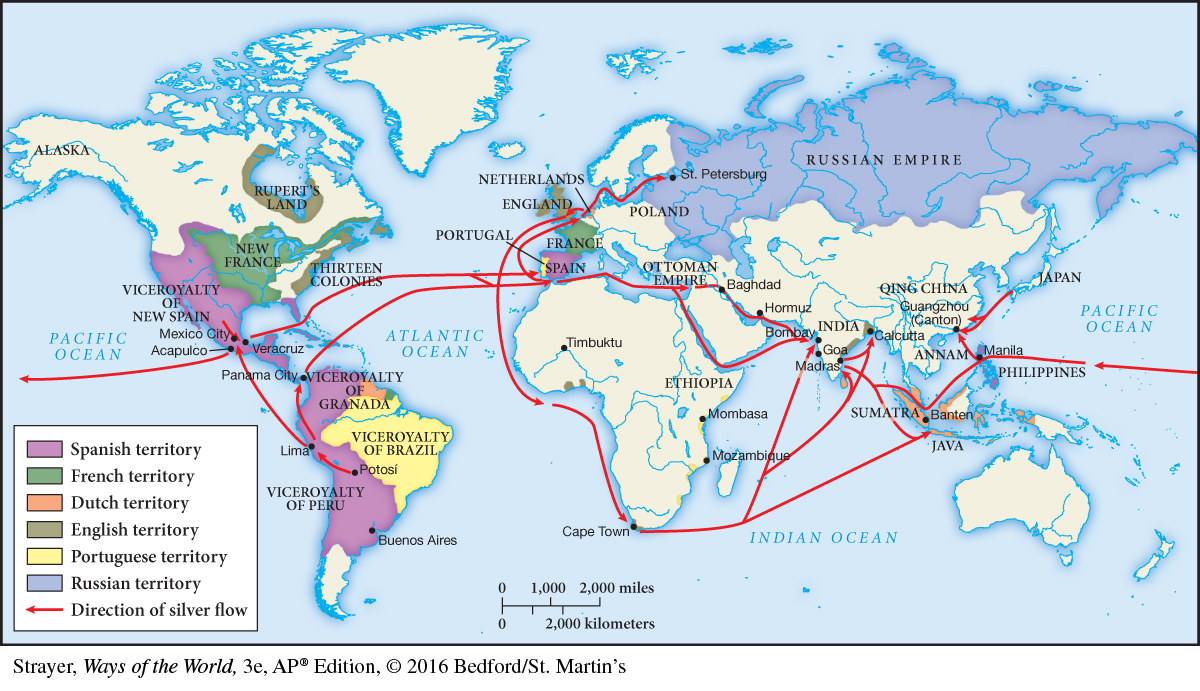Silver and Global Commerce
AP® EXAM TIP
You must know features and effects of the global trade of silver in this era.
Even more than the spice trade of Eurasia, it was the silver trade that gave birth to a genuinely global network of exchange (see Map 14.2). As one historian put it, silver “went round the world and made the world go round.”12 The mid-

Guided Reading Question
▪CONNECTION
What was the significance of the silver trade in the early modern era of world history?
At the heart of that Pacific web, and of early modern global commerce generally, was China’s huge economy, especially its growing demand for silver. In the 1570s, Chinese authorities consolidated a variety of tax levies into a single tax, which its huge population was now required to pay in silver. This sudden new demand for the white metal caused its value to skyrocket. It meant that foreigners with silver could now purchase far more of China’s silks and porcelains than before.
This demand set silver in motion around the world, with the bulk of the world’s silver supply winding up in China and much of the rest elsewhere in Asia. The routes by which this “silver drain” operated were numerous. Chinese, Portuguese, and Dutch traders flocked to Manila to sell Chinese goods in exchange for silver. European ships carried Japanese silver to China. Much of the silver shipped across the Atlantic to Spain was spent in Europe generally and then used to pay for the Asian goods that the French, British, and Dutch so greatly desired. Silver paid for some African slaves and for spices in Southeast Asia. The standard Spanish silver coin, known as a “piece of eight,” was used by merchants in North America, Europe, India, Russia, and West Africa as a medium of exchange. By 1600, it circulated widely in southern China. A Portuguese merchant in 1621 noted that silver “wanders throughout all the world … before flocking to China, where it remains as if at its natural center.”13
AP® EXAM TIP
Questions about the Potosí silver mines have appeared on past AP® exams.
In its global journeys, silver transformed much that it touched, and nowhere more profoundly than at Potosí, the site of a huge silver-mining operation in what is now Bolivia. (See Zooming In: Potosí.) In Spain itself, which was the initial destination for much of Latin America’s silver, the precious metal vastly enriched the Crown, making Spain the envy of its European rivals during the sixteenth century. Spanish rulers could now pursue military and political ambitions in both Europe and the Americas far beyond the country’s own resource base. “New World mines,” concluded several prominent historians, “supported the Spanish empire.”14 Nonetheless, this vast infusion of wealth did not fundamentally transform the Spanish economy, because it generated more inflation of prices than real economic growth. A rigid economy laced with monopolies and regulations, an aristocratic class that preferred leisure to enterprise, and a crusading insistence on religious uniformity all prevented the Spanish from using their silver windfall in a productive fashion. When the value of silver dropped in the early seventeenth century, Spain lost its earlier position as the dominant Western European power. More generally, the flood of American silver that circulated in Europe drove prices higher, further impoverished many, stimulated uprisings across the continent, and, together with the Little Ice Age of global cooling, contributed to what historians sometimes call a “General Crisis” of upheaval and instability in the seventeenth century. (For a broader discussion of the General Crisis, see “The Great Dying and the Little Ice Age” in Chapter 13.)
Japan, another major source of silver production in the sixteenth century, did better. Its military rulers, the Tokugawa shoguns, used silver-
In China, silver deepened the already-
Rarer, too, their timber grew, and rarer still and rarer
As the hills resembled heads now shaven clean of hair.
For the first time, too, moreover, they felt an anxious mood
That all their daily logging might not furnish them with fuel.16
China’s role in the silver trade is a useful reminder of Asian centrality in the world economy of the early modern era. Its large and prosperous population, increasingly operating within a silver-based economy, fueled global commerce, vastly increasing the quantity of goods exchanged and the geographic range of world trade. Despite their obvious physical presence in the Americas, Africa, and Asia, economically speaking Europeans were essentially middlemen, funneling American silver to Asia and competing with one another for a place in the rich markets of the East. The productivity of the Chinese economy was evident in Spanish America, where cheap and well-made Chinese goods easily outsold those of Spain. In 1594, the Spanish viceroy of Peru observed that “a man can clothe his wife in Chinese silks for [25 pesos], whereas he could not provide her with clothing of Spanish silks with 200 pesos.”17 Indian cotton textiles likewise outsold European woolen or linen textiles in the seventeenth century to such an extent that French laws in 1717 prohibited the wearing of Indian cotton or Chinese silk clothing as a means of protecting French industry.